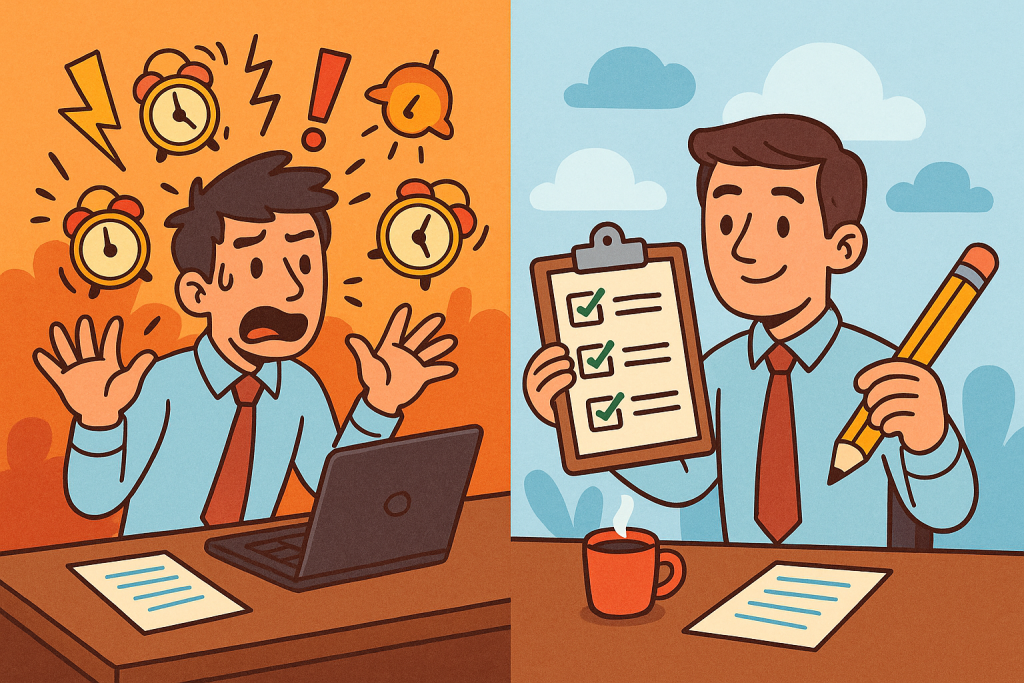Being intentional—not reactive—is key to sustainable productivity. This guide explores current trends like AI-powered workflows and “chronoworking,” plus practical steps to take control of your time and impact. Learn how to work smarter, not harder.

Why Intentional Work Matters Now
🚀 Shift from Coordination Overload
A recent Forbes analysis found that flexibility often turned into an “infinite workday,” where reactive coordination hijacked productivity time. That means humans aren’t optimizing productivity—they’re simply responding to interruptions.
Work Trends Favoring Intentionality
Emerging trends reinforce intentional work:
- Chronoworking—aligning tasks to your peak energy hours—boosts performance by respecting natural body rhythms.
- Micro-shifts, a Gen Z-led trend, encourages small intentional changes like focused learning sprints integrated into daily routines.
Together, these shifts support designing meaningful, purposeful work structures instead of putting out fires all day.
Core Mindset Shift: Proactive vs. Reactive
What Reactive Work Feels Like
- Responding constantly to emails, chats, and notifications
- No clear schedule or priority list—just jumping into what’s urgent
- End-of-day regret over lack of real progress
What Intentional Work Offers
- You set the agenda based on impact and goals
- Carefully scheduled focus slots for deep work
- Periodic reflections: “Am I working on what matters most?”
This shift is fundamental—you move from “What’s next?” to “What matters most?”
Trend Spotlight: Chronoworking & Micro-Shifts
Chronoworking
This method encourages aligning work with peak energy cycles. Gen Z workers increasingly favor non-traditional schedules—like working at night for deep focus—rather than standard 9–5.
Try it: Identify your ideal work hour (morning, midday, late evening) and reserve that for your most critical tasks.
Micro-Shifts
A Forbes feature describes “micro-shifts” as small, intentional changes—like reading one article daily or dedicating 15 minutes to skill-building—that compound into major improvement.
Try it: Schedule five-minute “intentional micro-shifts” daily to steer progress in tiny, consistent steps.
5 Practical Steps to Move Toward Intentional Work
1. Design a Weekly Intentional Plan
- Block deep work slots (e.g., 9–11 AM daily)
- Set three weekly top-priority goals
- Record hours spent reactive vs intentional—and analyze at week’s end
2. Time-Block with Purpose
- Use color-coded calendar blocks: green for focus, red for emails, blue for meetings
- Schedule 15-minute breaks to reset attention
- Turn off notifications during green blocks
3. Use Tools to Strengthen Intentionality
- AI assistants like Microsoft Copilot can automate repetitive tasks—freeing time for intentional work
- Personal initiative frameworks (e.g., action-based to-do lists) help you shift from planning mode to execution
4. Adopt Weekly Reflections
- Ask: Are my actions aligned to priorities?
- Adjust next week’s schedule based on lessons learned
5. Implement Micro-Shifts for Growth
- Identify one skill or project for small daily progress
- E.g., “Draft one email template per day” or “Read one section of a leadership article”
True Stories: Intentional Work in Action
From Reactive to Smart with AI
A company using Microsoft Copilot reduced routine email time and freed up three hours daily for deep project work . They replaced firefighting with strategic progress.
Thriving with Chronoworking
At Float.com, team members choose their hours. One team alternately tackled tasks at their peak—night owl vs. early bird—improving focus and output.
Quiet Thriving at the Individual Level
Rather than disengaging (“quiet quitting”), employees are practicing quiet thriving: proactively tweaking their roles, health habits, and daily routines to regain control.
Tools & Apps to Help You Stay Intentional
| Tool | Purpose |
|---|---|
| Calendar (Google, Outlook) | Time-blocking green focus slots |
| Focus apps (Forest, Focus@Will) | Reduce distractions during deep work |
| AI assistants (Copilot) | Automate repeat tasks for time back |
| To-do frameworks (GTD, Kanban) | Structure tasks for action |
Overcoming Common Obstacles
- Constant interruptions
- Solution: Signal “Do Not Disturb” with tools & calendar blocks
- Guilt over ignoring others
- Solution: Communicate your focus windows to coworkers
- Overbooking your calendar
- Solution: Leave unassigned buffer blocks to absorb spillover
Measuring Your Intentional Progress
- Track reactive vs intentional time via RescueTime or Toggl
- Weekly score-card: 80% intentional work? Good. 50%? Needs revision
- Monthly reflection: Are your significant goals moving forward?
Why Intentional Work Is Non-Negotiable
- Mental health & well-being
Reactive work boosts burnout; intentional work reduces stress - Strategic alignment
Intentional workers report more purpose, creativity, and impact - Future-proofing your career
The World Economic Forum predicts that soft skills and digital agility will be key in 2025—and intentional work fosters both
Final Thoughts
Shifting from reactive to intentional work isn’t just a nice-to-have—it’s essential in today’s environment. With trends like chronoworking and micro-shifts gaining traction, you can reclaim productivity and purpose through weekly planning, tools, reflection, and small consistent resets. This change is radical because it turns busy days into deliberate achievements.
References
1. Ashley, S. (2024, April 19). Busyness vs. Intentional Focus—Which One Is Winning? Medium. Retrieved from https://staceyashley.medium.com
2. Li, L., Shi, G., & Zheng, X. (2025). Differential Effects of Proactive and Reactive Work Connectivity Behavior After‑Hours on Well‑Being at Work: A Boundary Theory Perspective. Behavioral Sciences, 15(3), 320.https://staceyashley.medium.com
3. Bravery, K., & Self, W. (2025). Rethinking Productivity in the Age of AI. Mercer. Retrieved from https://www.mercer.com






